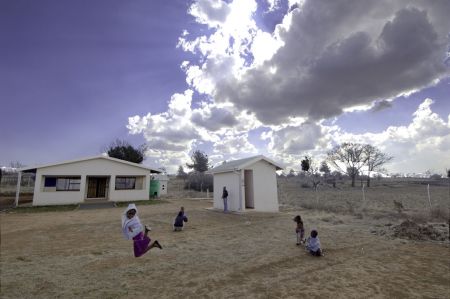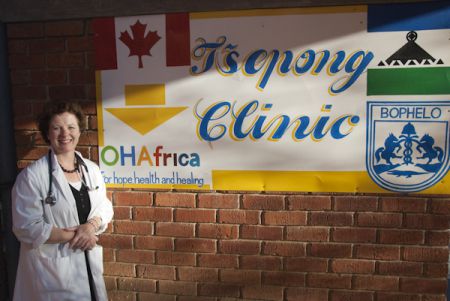"Are you going to help the people who are [HIV] positive?" A South African crossing guard at South Africa’s border asked Dr. Anne-Marie Zajdlik on her way to Lesotho, a landlocked nation surrounded by South Africa, where her HIV treatment clinic is located.
"You bet I am," Dr. Anne-Marie Zajdlik, a mom, a family doctor, a McMaster alumni, and HIV/AIDS activist, recorded in her journal, "all 300,000 of them."
Her battle against the global HIV pandemic, which brought her to Lesotho, began in Canada.
Dr. Anne-Marie Zajdlik attended McMaster medical school after studying three years at University of Guelph in Biomedical Science and Human Biology. In 1987, during her second year at McMaster, Zajdlik studied an elective in Infectious disease at Dalhousie University in Halifax and worked with a team that was treating the first HIV-positive patient on the east coast.
"He," referring to the first HIV-positive patient, "was left by his partner, disowned by his family, and deserted by medical staff," Zajdlik remembered, "nurses were afraid, even cleaning staff wouldn't go into his room."
At that time, Harrison's Principles of Internal Medicine, a 3000 pages textbook used by medical students, internists and junior doctors, only had a paragraph on HIV. Stigma, fear, and a lot of unknown surrounded the then 6-year-old incurable disease.
" I was quite moved by his isolation," Zajdlik said. She spent hours sitting at his bedside talking to him. The depth of his pain, his incredible strength, and his will to survive inspired her to go back and study more.
Zajdlik opened her family practice in 1989, right after graduating from McMaster, and began treating HIV positive patients. By 2002, her clinic became the only remaining HIV-treating facilities in southwestern Ontario. The HIV positive population in her practice had grown to an overwhelming number of 75.
What followed were a series of doors miraculously opened and strings anonymously pulled. First, she was invited to speak in front of the AIDS Bureau Clinic Directors. Then, with the help of the AIDS Bureau funded by the Ministry of Health, and a health planner whom she was told to hire, a team of thirty "all passionate, all eager and all ready to work" professionals came together and became The Regional HIV Clinic Planning Committee. She was no longer alone and a regional HIV clinic was forming.
In 2004, Zajdlik and her team named the yet-to-be-born clinic, "The Masai Centre for Local, Regional and Global Health."
Masai was the name of a baby Zajdlik delivered a year earlier at the Guelph General Hospital. He was the first HIV-negative baby born by an HIV-positive mother.
"Holding that baby inspired me to open this clinic," said Zajdlik. The first Masai Centre opened its doors to the public in 2005; Four years later, a satellite clinic was opened in Waterloo.
On Dec. 1, 2005, coincidently on annual World AIDS Day, Zajdlik decided to do something about AIDS in Africa after reading—four times in two weeks—Stephen Lewis' Race Against Time, a discussion on United Nations' Millennium Development Goals.
Zajdlik trail-blazed a campaign to raise one million dollars in support of an HIV-treatment clinic in Leribe, Lesotho, a district in a landlocked nation in southern Africa. The Tsepong Clinic, literally translated from Sesotho, "Place of Hope,” provides life-saving care and antiretroviral (ARV) treatment to this HIV/AIDS-stricken district.
According to Stephen Lewis Foundation's website, 30-40 per cent of the people in Lesotho are already infected, a number which has been growing rapidly since the first reported case in 1986. In Dec. 1999, the Ministry of Heath of Lesotho reported 10,880 cases of "full-blown AIDS." Six years later, Zajdlik said there are 300,000 people infected with no treatment at all.
"They are all left to die," Zajdlik said, leaving behind "more than 100,000 orphans."
The first Tsepong Clinic opened in Dec. 1, 2004, also on World AIDS Day. Zajdlik visited and worked at the clinic in August 2006.
"I haven't been the same person since. I will no longer be the same person ever again," Zajdlik said with a definite tone, "The world is a tough place—a lot of poverty, a lot of suffering; a lot of unnecessary poverty, a lot of unnecessary sufferings."
The goal of a HIV treatment is to bring the amount of virus in a person's bloodstream down to a number that is undetectable. When the virus is undetectable, it is also non-transmittable. Zajdlik used to prescribe patients with a handful of 7-8 pills three times a day with many side effects. Now, treatment is down to one complete-pill daily with very few side effects. Patients could live normal lives with a normal life span, even though HIV cannot be completely eradicated.
In third world nations, however, there is "[an] absence for HIV-positive pregnant women to have the drug that can prevent the transmissions of virus, and then have the drugs to keep them alive after they've given birth," Stephen Lewis pointed out in a University Seminar on Global Health at Duke University.
According to Lewis, only 30 to 33 per cent have access to drugs to prevent transmission of the virus to their babies. 50 per cent of the infants that are born HIV-positive die before the age of two and 80 per cent die before the age of five.
"It's so, so destroying that [these women] might not get the antiviral treatment when they need it and worse in their mind would be the birth of an infant who is HIV-positive when the infant doesn't have to be," said Lewis.
An HIV positive pregnant woman has a 40 per cent chance that the virus will transmit to her newborn. The introduction of ARV (Antiretroviral drug) at sixteen weeks of pregnancy decreases this risk to less than 1 per cent, or to 2 per cent if one dose of an ARV is used at the time of labour, Zajdlik explained.
Since the introduction of a national antenatal screening program in Canada in 1996, which provides all pregnant women an opportunity to be tested for HIV and be treated if they are found to be HIV positive at no cost to them, there has not been a child born with HIV in Canada.
"The infant could be HIV negative," said Lewis, referring to the situation in developing nations. The suffering of these children is unnecessary.
A study has shown that if everyone who is at risk on the planet is being tested and treated appropriately, the AIDS pandemic could end within six months. All that an AIDS-pandemic-free world needs is $100 billion. Does that sound like a lot? Well, the Bush administration was spending $10 billion a month on war in Iraq.
"If ordinary people knew that, and were given the opportunity to take a stand, and have their say on how global money is spent, I believe they'd choose to end the global pandemic of AIDS,” said Zajdlik who is convinced that one nation could be AIDS free and set an example for the world.
In April 2006, six students from University of Guelph caught onto the campaign and pledged to raise $100,000 for the Tespong clinics. They hired an African-based craft agency, Inina, which employed women to work from home and produce beaded bracelets to be sold at $5 each—$1 goes to the workers and $4 to the campaign. It was a stunning success, according to the Bracelets of Hope website. Successful enough that the "Masai for Africa" campaign changed its name to the Bracelets of Hope campaign within months.
Today, the Tsepong clinic in Leribe cares for 21,000 HIV positive patients, with 280,000 more to go.

